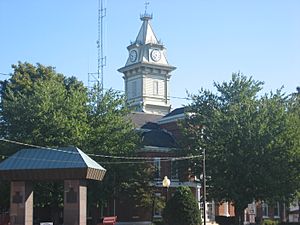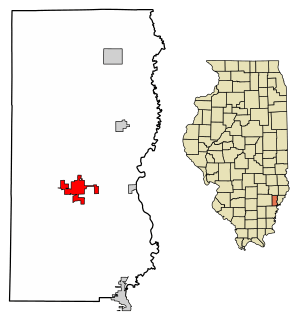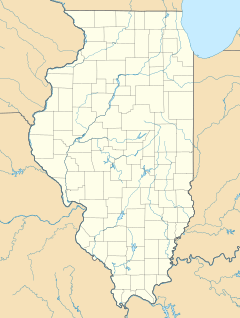Albion, Illinois facts for kids
Quick facts for kids
Albion, Illinois
|
|
|---|---|

Edwards County Courthouse, a local landmark
|
|

Location of Albion in Edwards County, Illinois.
|
|
| Country | United States |
| State | Illinois |
| County | Edwards |
| Area | |
| • Total | 2.18 sq mi (5.65 km2) |
| • Land | 2.14 sq mi (5.53 km2) |
| • Water | 0.05 sq mi (0.12 km2) |
| Elevation | 525 ft (160 m) |
| Population
(2020)
|
|
| • Total | 1,971 |
| • Density | 922.75/sq mi (356.32/km2) |
| Time zone | UTC-6 (CST) |
| • Summer (DST) | UTC-5 (CDT) |
| ZIP Code(s) |
62806
|
| Area code(s) | 618 |
| FIPS code | 17-00568 |
| GNIS ID | 2393906 |
Albion is a city in Edwards County, Illinois, United States. It is also the county seat, which means it's where the main government offices for the county are located. In 2020, about 1,971 people lived there. The city got its name "Albion" from an old, poetic name for the island of Great Britain.
Contents
History of Albion
The area now known as Albion was first called "Mr. Morris Birkbeck's English Prairie." This was in 1817. Morris Birkbeck, an English Quaker, and George Flower started the town. They wanted to create a special community where everyone lived and worked together.
In 1818, Birkbeck and Flower had a disagreement. The part of English Prairie where Flower lived was then named Albion.
Becoming the County Seat
In 1821, Albion became the county seat of Edwards County. Before that, the county seat was in Palmyra, about eighteen miles to the east. However, people in the larger town of Mount Carmel thought their town should be the county seat.
Four groups of soldiers from Mount Carmel marched towards Albion. They wanted to take the county documents from the courthouse. The problem was solved in 1824. Wabash County was separated from Edwards County. Mount Carmel became the county seat of Wabash County. These two counties are among the smallest in Illinois.
English Roots and Brewing Connections
Albion has interesting ties to England and the art of brewing beer. George Flower and Morris Birkbeck bought a large area of land in the southern Illinois Territory. They encouraged settlers from England to join them. Among these settlers was George's father, Richard Flower. He was an experienced brewer who taught his son about making popular beers like London Porter. Richard Flower moved across the Atlantic with all his remaining children.
Abolitionist Efforts and a Family's Struggle
The settlement of Albion strongly believed in ending slavery. They welcomed formerly enslaved people who had escaped from Kentucky. The Flower family and other leaders supported these new residents. However, these free African-Americans were always in danger. Bounty hunters tried to kidnap them and force them back into slavery.
Around 1823-1824, a group of eight to ten kidnappers took some free African-American residents from Albion. They headed south with their captives. Richard Flower's youngest son, Edward, led an armed group to chase them. Edward was only eighteen years old. His group successfully caught the kidnappers and freed the captives. The kidnappers were then brought to face the law.
Friends of the kidnappers' allies planned to get revenge. They wanted to harm young Edward Flower or his father. According to some old newspaper stories, a cousin also named Richard was sadly mistaken for Edward's father. He was killed in a planned argument and fight. Another time, a bullet was shot through a window of Richard's house. It hit a mirror right above his head.
Because of these dangers, the family decided Edward Flower needed to leave the country. After 1825, he returned to England. There, he decided to follow the family business of brewing. After a difficult start, Flower's Brewery in Stratford-upon-Avon became very famous in England. It continued as a separate company until the 1950s, and the brand still exists today.
Edward loved Illinois and missed his life in America with his family. He regretted having to leave and often thought about returning. During the American Civil War, Edward Flower gave speeches in Britain and Ireland. He supported the Union and spoke against slavery. In 1866, after the war ended, he visited the U.S. for six months with his wife, Celina.
Albion Tornado of 1990
On June 2, 1990, a powerful Tornado hit Albion. This was part of a larger group of tornadoes in the Lower Ohio Valley. The tornado was rated F4, which means it was very strong. Famous video footage was taken as it moved through the town. The video showed the tornado forming several smaller swirling parts, like arms reaching out.
Geography and Location
Albion is located in the southern part of Edwards County. Two important roads, Illinois Route 130 and Illinois Route 15, meet in the city.
- Route 130 goes north about 25 miles to Olney. It goes south about 10 miles to Grayville.
- Route 15 goes east about 16 miles to Mount Carmel. It goes west about 16 miles to Fairfield.
Albion covers a total area of about 2.18 square miles (5.65 square kilometers). Most of this area, about 2.14 square miles (5.53 square kilometers), is land. A small part, about 0.05 square miles (0.12 square kilometers), is water.
On September 19, 2017, a 3.8-magnitude earthquake happened about seven and a half miles outside of Albion.
Climate
Albion has a climate with warm summers and cool winters.
| Climate data for Albion | |||||||||||||
|---|---|---|---|---|---|---|---|---|---|---|---|---|---|
| Month | Jan | Feb | Mar | Apr | May | Jun | Jul | Aug | Sep | Oct | Nov | Dec | Year |
| Mean daily maximum °F (°C) | 39.9 (4.4) |
43.7 (6.5) |
55.2 (12.9) |
67.7 (19.8) |
77.6 (25.3) |
86.3 (30.2) |
90.0 (32.2) |
88.6 (31.4) |
82.2 (27.9) |
70.3 (21.3) |
55.7 (13.2) |
43.2 (6.2) |
66.7 (19.3) |
| Mean daily minimum °F (°C) | 23.2 (−4.9) |
25.2 (−3.8) |
35.0 (1.7) |
45.3 (7.4) |
55.0 (12.8) |
63.6 (17.6) |
67.2 (19.6) |
65.5 (18.6) |
58.6 (14.8) |
46.7 (8.2) |
36.4 (2.4) |
26.7 (−2.9) |
45.7 (7.6) |
| Average precipitation inches (mm) | 3.2 (81) |
2.7 (69) |
4.4 (110) |
4.4 (110) |
4.8 (120) |
4.1 (100) |
3.6 (91) |
3.4 (86) |
3.0 (76) |
2.9 (74) |
3.7 (94) |
3.3 (84) |
43.4 (1,100) |
| Source: Weatherbase | |||||||||||||
Population and People
| Historical population | |||
|---|---|---|---|
| Census | Pop. | %± | |
| 1850 | 365 | — | |
| 1870 | 613 | — | |
| 1880 | 875 | 42.7% | |
| 1890 | 937 | 7.1% | |
| 1900 | 1,162 | 24.0% | |
| 1910 | 1,281 | 10.2% | |
| 1920 | 1,584 | 23.7% | |
| 1930 | 1,666 | 5.2% | |
| 1940 | 1,855 | 11.3% | |
| 1950 | 2,287 | 23.3% | |
| 1960 | 2,025 | −11.5% | |
| 1970 | 1,791 | −11.6% | |
| 1980 | 2,285 | 27.6% | |
| 1990 | 2,116 | −7.4% | |
| 2000 | 1,933 | −8.6% | |
| 2010 | 1,988 | 2.8% | |
| 2020 | 1,971 | −0.9% | |
| U.S. Decennial Census | |||
According to the 2020 census, there were 1,971 people living in Albion. There were 926 households and 532 families. The population density was about 903 people per square mile.
Most of the people in Albion (94.11%) were White. About 0.61% were African American, and 1.01% were Asian. About 1.52% of the population identified as Hispanic or Latino.
In terms of households, 36.1% had children under 18 living with them. About 38.66% were married couples. The average household had about 3.04 people. The average family had about 2.36 people.
The median age in the city was 38.9 years. This means half the people were younger than 38.9 and half were older. About 27.9% of the population was under 18 years old. About 17.5% were 65 years or older.
The median income for a household in Albion was $43,971. For families, the median income was $64,375. About 18.1% of the population lived below the poverty line. This included 23.4% of those under 18.
Notable People from Albion
Many interesting people have connections to Albion:
- Harold Huntley Bassett: A major general in the U.S. Air Force.
- Morris Birkbeck: One of the founders of Albion and the first Illinois Secretary of State.
- Louis Lincoln Emmerson: Served as Secretary of State of Illinois and later as Governor of Illinois.
- Benjamin Orange Flower: A well-known journalist.
- Edward Fordham Flower: An English brewer who started a famous brewery.
- Harold A. Garman: A U.S. Army medic who received the Medal of Honor during World War II.
- Guy U. Hardy: A former congressman from Colorado.
- Jeff Keener: A former pitcher for the St. Louis Cardinals baseball team.
- H. H. Kohlsaat: A publisher who was a close friend to five U.S. presidents.
- George Frederick Pentecost: A famous clergyman and evangelist. He worked with revivalist D.L. Moody.
- William Pickering: The fifth governor of Washington Territory.
See also
 In Spanish: Albion (Illinois) para niños
In Spanish: Albion (Illinois) para niños




